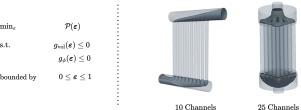基于密度的均匀流管优化设计拓扑优化策略
IF 3
3区 工程技术
Q3 COMPUTER SCIENCE, INTERDISCIPLINARY APPLICATIONS
引用次数: 0
摘要
流动歧管是一种通过多个通道分配或收集流体的装置,在许多流体和能源系统的性能中起着至关重要的作用。然而,设计出能够保证均匀流动分布的高效歧管仍然具有挑战性,特别是对于多通道三维歧管。本研究提出了一个可扩展的拓扑优化框架,用于系统地设计多通道流形。该方法建立在传统的基于密度的拓扑优化公式的基础上,引入了流量不均匀系数作为显式约束。这种新颖的方法是使用开源CFD套件SU2中的不可压缩Navier-Stokes流求解器实现的。以一个同时设计进、出口流形的平面z型流形为例,对比两种已建立的拓扑优化策略,对所提方法的性能进行了基准测试。结果表明,该方法在显著降低计算成本的同时,获得了与现有方法相当的流动均匀性。此外,当应用于大规模的三维问题时,该方法产生了可行的设计,实现了均匀的流动分布,并表现出创新的几何特征。这些结果突出了该方法的鲁棒性和可扩展性。本文章由计算机程序翻译,如有差异,请以英文原文为准。

Density-based topology optimization strategy for optimal design of uniform flow manifolds
Flow manifolds are devices that distribute or collect fluid across multiple channels, playing a crucial role in the performance of many fluid and energy systems. However, designing efficient manifolds that ensure uniform flow distribution remains challenging, especially for multi-channel three-dimensional manifolds. This study presents a scalable topology optimization framework for systematically designing multi-channel flow manifolds. The proposed method builds on the conventional density-based topology optimization formulation by introducing a flow maldistribution coefficient as an explicit constraint. This novel approach was implemented using the incompressible Navier–Stokes flow solver available in the open-source CFD suite SU2. The performance of the proposed method was benchmarked against two established topology optimization strategies using an exemplary planar z-type flow manifold, where both the inlet and outlet manifolds were designed simultaneously. The results demonstrate that the proposed method achieves flow uniformity comparable to established approaches while significantly reducing computational costs. Furthermore, when applied to large-scale three-dimensional problems, the proposed method produces feasible designs that achieve uniform flow distribution and exhibit innovative geometrical features. These results highlight the robustness and scalability of the proposed method.
求助全文
通过发布文献求助,成功后即可免费获取论文全文。
去求助
来源期刊

Computers & Fluids
物理-计算机:跨学科应用
CiteScore
5.30
自引率
7.10%
发文量
242
审稿时长
10.8 months
期刊介绍:
Computers & Fluids is multidisciplinary. The term ''fluid'' is interpreted in the broadest sense. Hydro- and aerodynamics, high-speed and physical gas dynamics, turbulence and flow stability, multiphase flow, rheology, tribology and fluid-structure interaction are all of interest, provided that computer technique plays a significant role in the associated studies or design methodology.
 求助内容:
求助内容: 应助结果提醒方式:
应助结果提醒方式:


